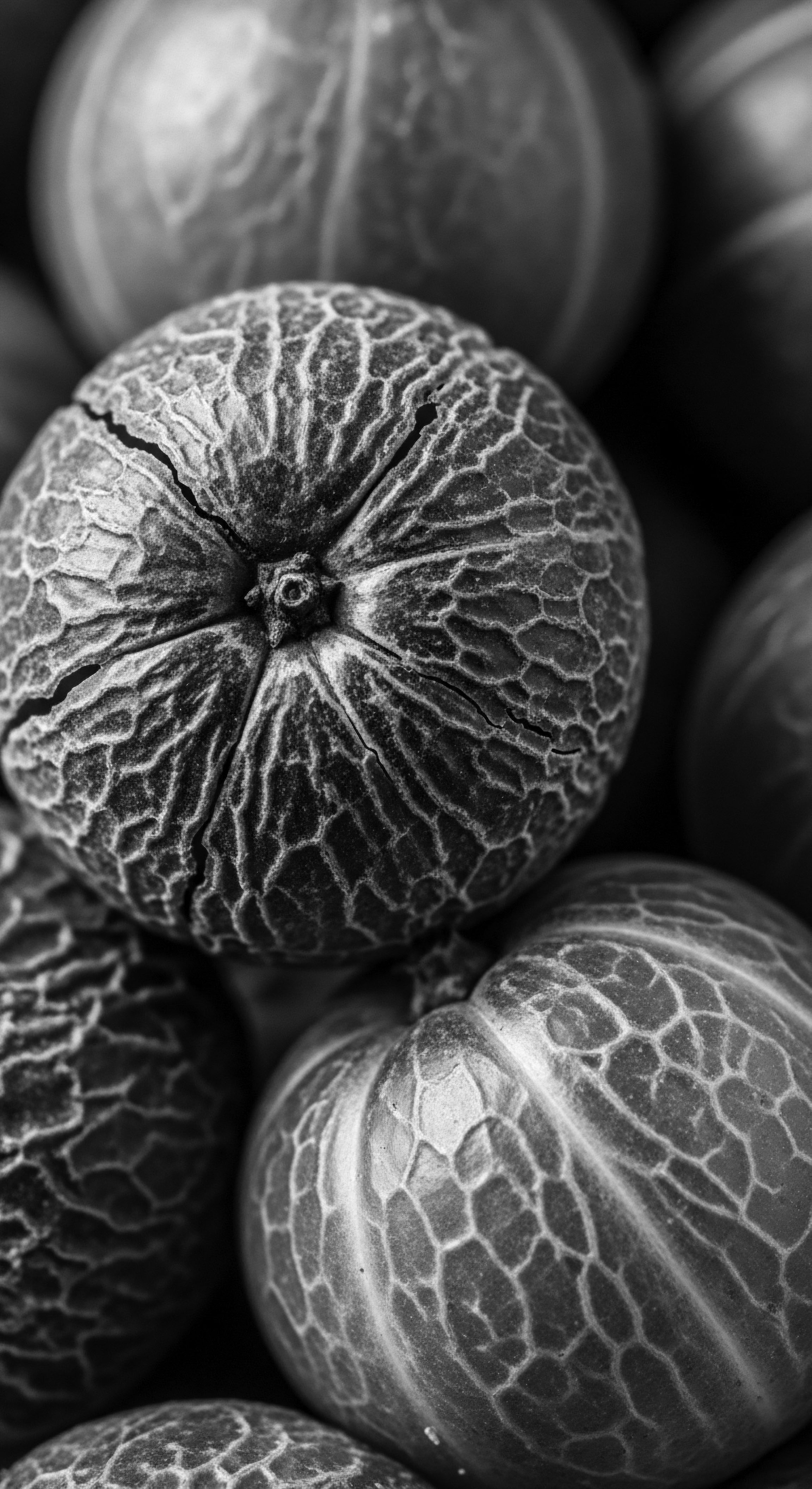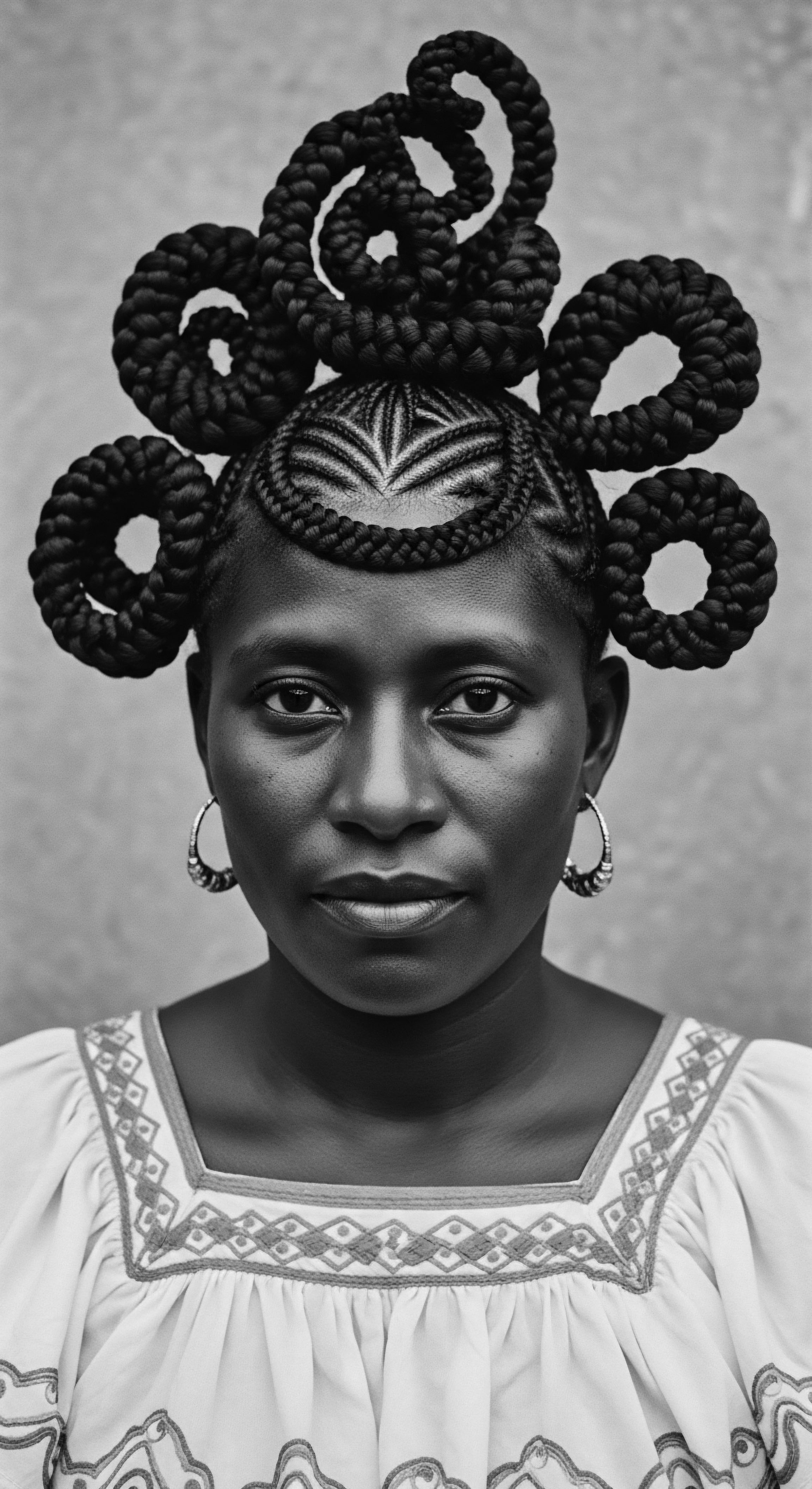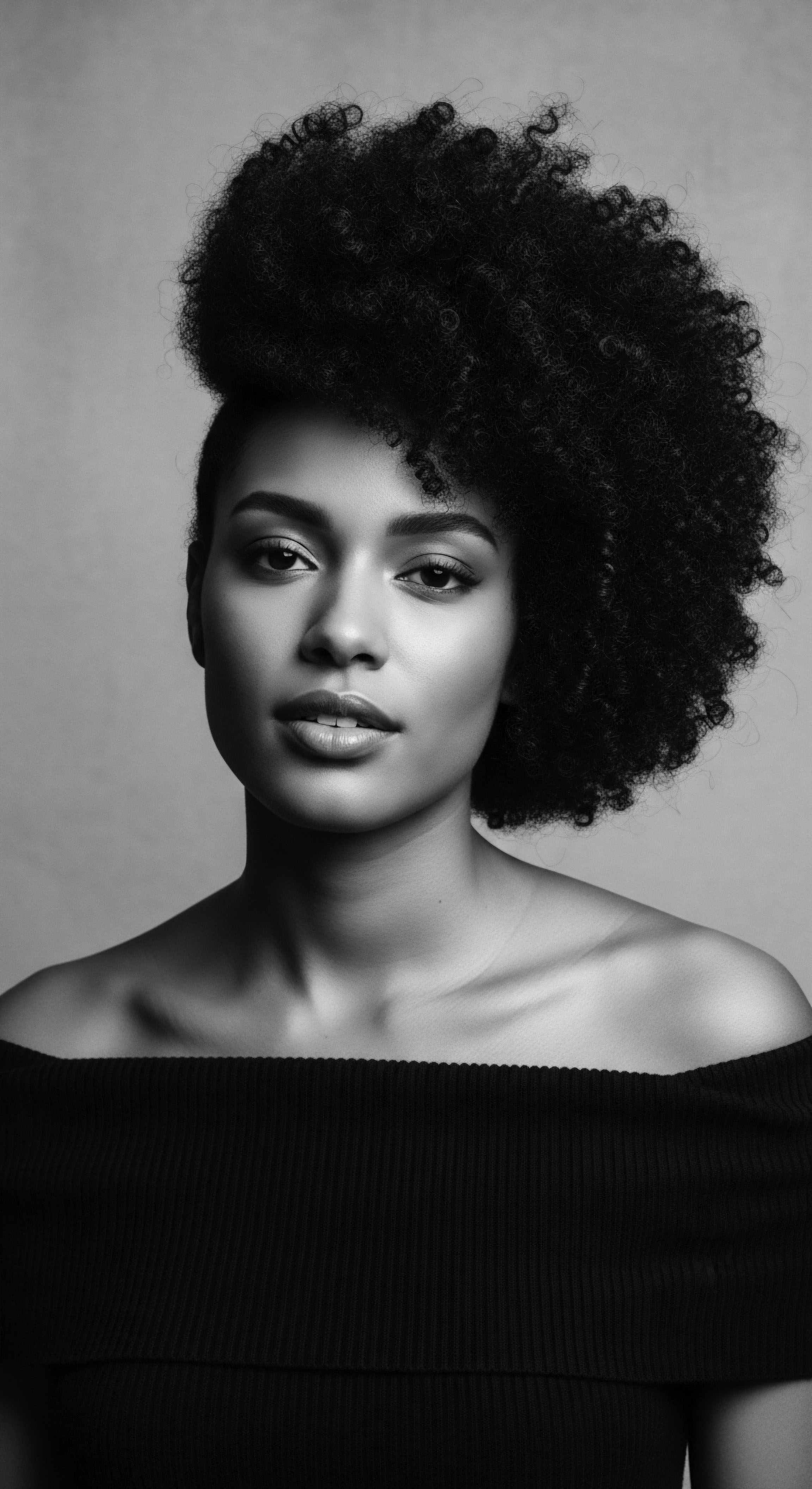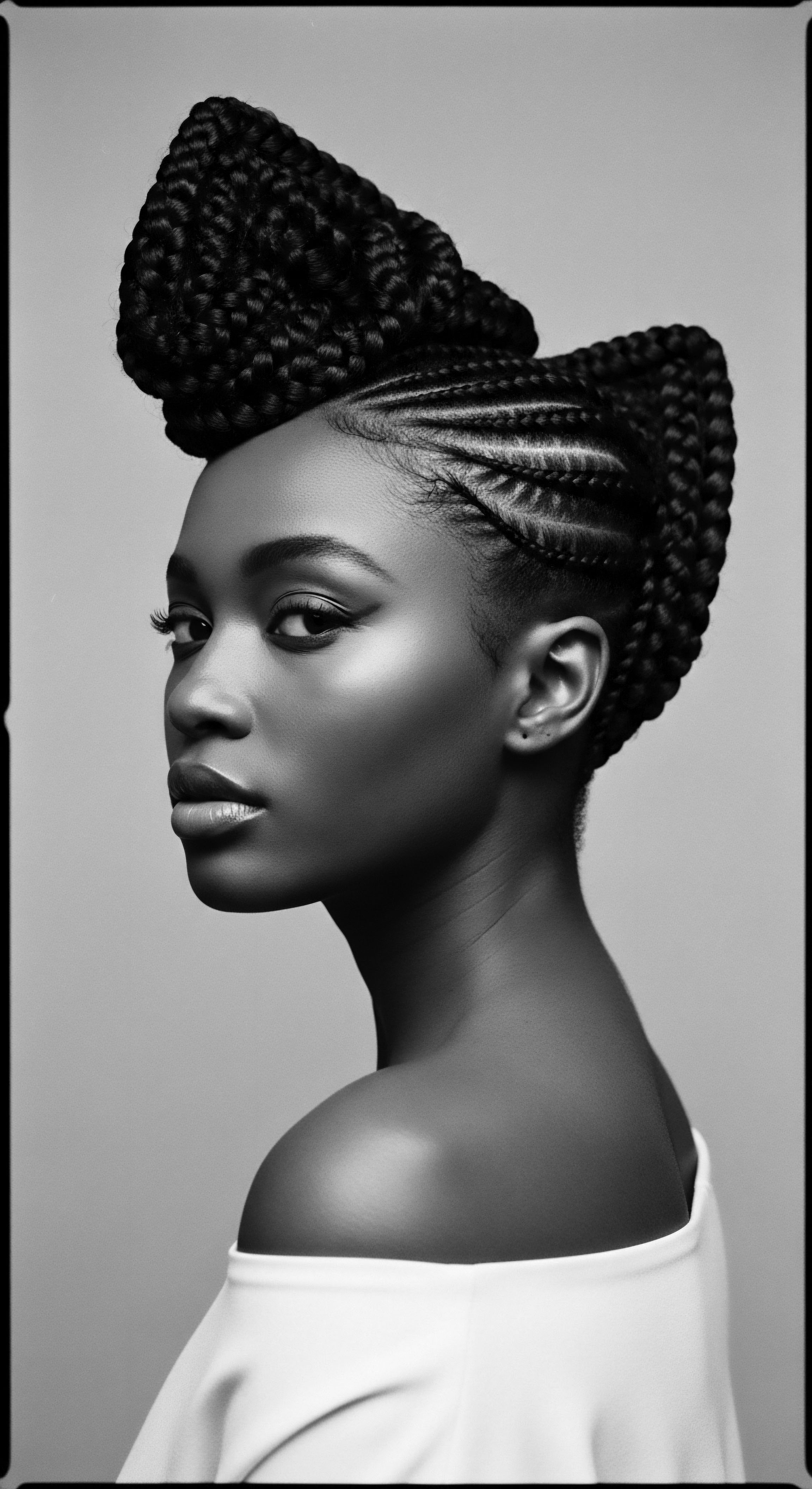
Roots
The textured strand, a helical wonder reaching skyward from the scalp, carries within its very fiber the ancient echoes of human stories. For generations uncounted, across the vast and varied lands of Africa, societies held a profound reverence for the crowning glory ❉ hair. This deep respect was not a fleeting trend, nor a simple matter of aesthetics.
It was, rather, a layered dialogue with the world, a language spoken through adornment, protection, and concealment. To inquire why traditional African societies covered textured hair is to seek entry into a sacred vault of ancestral wisdom, where each wrapped coil and shrouded lock whispers tales of heritage, spirituality, and societal order.
The unique contours of textured hair, with its inherent strength and delicate nature, necessitated specific forms of care and adornment. Its distinct curl patterns, ranging from softly undulating waves to tightly coiling spirals, meant it often required gentle handling and considered protection from environmental elements. In sun-drenched savannas and humid forests alike, the elements offered both life and challenge. Dust, scorching sun, and drying winds could compromise hair’s vitality.
Covering, then, emerged as a pragmatic response, a practical shield against the relentless forces of nature that sought to diminish hair’s natural luster. This protective instinct, however, quickly intertwined with far deeper cultural and spiritual meanings.

What are the Foundational Biological Aspects of Textured Hair?
To truly appreciate the traditions of covering, one must first glimpse the very structure of textured hair, a marvel of biological engineering. Unlike straight hair, which typically possesses a round cross-section, textured hair often exhibits an elliptical or even flat cross-section. This unique shape causes the hair shaft to bend and twist upon itself as it grows, creating the characteristic curl patterns.
The points where these bends occur are naturally weaker, making textured hair more susceptible to breakage if mishandled. Each bend represents a point where moisture can escape more readily, contributing to dryness, a common concern across all hair types, but particularly pronounced in tightly coiled textures.
The hair shaft itself, composed primarily of a protein called Keratin, grows from the hair follicle, a tiny organ nestled within the skin. The shape of this follicle largely dictates the shape of the hair strand. In textured hair, the follicle is often curved, causing the hair to grow out of the scalp at an angle, further contributing to its coiled nature. The cuticle, the outermost layer of the hair, is composed of overlapping scales.
In textured hair, these scales tend to be raised, providing less uniform coverage along the shaft. This structural characteristic makes textured hair inherently more prone to tangling and makes the absorption and retention of moisture a continuous process. Understanding these biological realities helps us grasp the deep wisdom embedded in ancestral care practices, including covering.
Ancestral hair covering practices were not merely about appearance, but deeply intertwined with the fundamental biology and environmental realities of textured hair.

How Did Cultural Understanding Shape the Language of Hair?
Across African societies, hair transcended its biological function to become a powerful language, a visual lexicon communicating identity, status, and belief. The terms used to describe hair reflected this deep cultural resonance. For instance, among many West African groups, specific names existed for various curl patterns, textures, and even the hairstyles themselves. These names often carried poetic or symbolic meanings, referring to natural phenomena, animal characteristics, or social roles.
Hair was never a generic entity; it was a specific, living aspect of one’s being, deserving of its own rich vocabulary. This conceptual framework elevated hair beyond mere biology into the realm of profound cultural significance, thereby influencing why and how it might be protected or veiled.
The very act of naming hair styles or textures could connect an individual to their lineage or community. Consider the traditional terms for various braided styles, each with its own history and communal significance. Such linguistic specificity underscored the importance of hair in daily life and ritual.
When hair was covered, this act, too, carried specific names and implications, often understood intuitively within the community. The covering did not erase the hair’s identity; it transformed its public presentation, speaking a different language about the wearer’s state, intentions, or position within the social fabric.
An illustrative historical example is the Yoruba Concept of Ori. Among the Yoruba people of Nigeria, the head, or Ori, is considered the seat of one’s spiritual essence and destiny. The hair, as an extension of the ori, was often seen as a conduit for spiritual energy and a significant identifier of a person’s physical and metaphysical self. Protecting this vital area with coverings was not merely a stylistic choice; it was a profound act of spiritual guardianship, ensuring the integrity of one’s destiny and maintaining a sacred connection to the divine (Drewal, 1990, p.
19). This deep spiritual belief directly contributed to the societal imperative to cover and protect the hair.

What Traditional Elements Influenced Hair’s Growth?
Beyond inherent biology, external factors significantly shaped hair’s vitality in traditional African societies. Environmental conditions, ranging from intense sunlight to dry air, naturally impacted hair moisture and strength. A diet rich in plant-based foods, essential fats, and protein, often sourced directly from the land, provided the building blocks for healthy hair growth. Traditional communities possessed an intuitive grasp of nutritional science, linking a healthy internal state to external vibrancy.
Certain plants and oils, harvested from the local ecosystem, were understood to possess properties that supported hair health. These ingredients were used in meticulous preparations, creating a lineage of hair care practices passed down through generations. The knowledge of these natural remedies and their efficacy was an ancestral inheritance, a testament to keen observation and sustained engagement with the natural world. Covering hair, in this context, complemented these dietary and topical practices by safeguarding the hair from external aggressors, allowing the internal and applied nourishment to work undisturbed.
A look at how certain groups interacted with their environment and hair can be illuminating. For instance, groups residing in arid regions might have used denser, more occlusive coverings and richer oils to combat dryness. Conversely, those in more humid areas might have employed lighter coverings, focusing on breathability while still offering protection. These adaptive practices reveal a sophisticated understanding of hair’s needs in varying ecological contexts, all leading to the common thread of protecting the hair from the harsh elements, often through covering.

Ritual
The reasons traditional African societies covered textured hair transcended simple environmental protection. The practice was woven into the very fabric of daily life, ritual, and spiritual expression. Hair became a canvas, a marker, and a sacred extension of the self, its public presentation carefully curated through coverings. These acts of veiling were deliberate, imbued with meanings that spoke of identity, status, spirituality, and community.
Hair, particularly the way it was styled or covered, served as a powerful non-verbal communicator. It could signal one’s age, marital status, social standing, or even readiness for specific rites of passage. The very choice of fabric, the manner of wrapping, or the presence of certain adornments on the head covering conveyed nuanced messages within the community.
In this way, covering hair was not about hiding; it was about communicating. It was a sophisticated visual language, understood by all members of a society, contributing to the harmony and order of communal life.

How Did Protective Styling Connect to Ancestral Hair Care?
Many traditional African hairstyles were inherently protective, designed to minimize manipulation, guard the hair shaft, and promote length retention. Braids, twists, and locs, often adorned with cowrie shells, beads, or precious metals, were not merely decorative. They served as foundational protective measures, keeping the hair contained and shielded from breakage. When these styles were combined with head coverings, the protection intensified, creating a dual shield against both physical damage and environmental stressors.
The ancestral roots of protective styling laid a groundwork for understanding the role of coverings. Before a woman might wrap her head, her hair would often be intricately braided or twisted. This preparation was not just about tidiness; it was about preserving the hair’s integrity.
The covering then became an additional layer of preservation, allowing the protective style underneath to perform its function without external interference. This layering of care speaks volumes about the value placed on hair health and maintenance.
Consider the enduring legacy of such practices. Many contemporary protective styles find their direct lineage in these ancestral techniques. The act of covering often meant that these labor-intensive styles could be preserved for extended periods, reducing the need for daily manipulation and further promoting hair health. This deep connection between styling and covering shows a sophisticated understanding of hair biology long before modern scientific terms existed.

What Spiritual Significance Did Hair Coverings Hold?
Beyond the pragmatic and social, hair covering in traditional African societies often held profound spiritual weight. In many belief systems, the head was considered a sacred part of the body, a spiritual nexus connecting an individual to the divine, to ancestors, or to the spiritual realm. Covering the head, and by extension the hair, was an act of reverence, respect, and humility in the presence of spiritual forces or during sacred ceremonies. It could also signify a state of spiritual readiness or engagement.
Certain rituals mandated head coverings for participants, signifying their participation in sacred rites or their devotion to specific deities. The act of wrapping the head could also be a form of spiritual shielding, protecting the wearer from negative influences or preserving one’s spiritual energy. The choice of fabric, its color, and the way it was tied could all carry specific spiritual connotations, understood by initiates and elders. This spiritual dimension elevates hair covering from a mere custom to a sacred practice, deeply rooted in the worldview of the community.
Hair coverings in traditional African societies often served as a profound spiritual shield, connecting the wearer to the divine and protecting their sacred essence.
An example of this spiritual significance can be seen in the practices of some indigenous communities in Southern Africa, where head coverings were donned by diviners or spiritual healers during trance states or ceremonial duties. The covering served to focus spiritual energy and to visually distinguish the individual in their sacred role. The reverence for hair as a channel for spiritual flow meant its protection, often through elaborate coverings, was paramount during such moments of heightened spiritual connection. This highlights a powerful facet of why textured hair was covered ❉ not just for physical protection, but for metaphysical safeguarding.
The relationship between hair and spirituality is beautifully captured in the traditional African reverence for the Ancestors. Hair, having grown from the body, could be seen as holding a piece of one’s lineage and history. Covering it, then, was also an act of respect for those who came before, a silent acknowledgement of a continuous, sacred chain of being.

How Did Status and Identity Shape the Act of Covering?
In many traditional African societies, hair coverings were visual cues of social standing, age, and identity. A young, unmarried woman might wear her hair uncovered or in simpler styles, while a married woman, particularly one with children, would typically wear a more elaborate headwrap. This visible distinction communicated her new status within the community, signifying maturity, responsibility, and respect.
The material, color, and method of wrapping a head covering often conveyed wealth, power, or affiliation with a particular family or clan. Certain fabrics, dyes, or adornments were exclusive to royalty, elders, or individuals of high societal standing. The intricate artistry of a headwrap could be a testament to the skill of the wearer or the person who tied it, becoming a personal statement of artistry and identity. These coverings were not static; they changed with a person’s life stages, serving as a dynamic visual biography.
A simple table illustrates the depth of meaning attached to coverings:
| Aspect of Covering Material of Fabric |
| Common Symbolic Meanings Wealth, trade relationships, ceremonial purpose |
| Aspect of Covering Color of Fabric |
| Common Symbolic Meanings Mood, spiritual connection, social group affiliation |
| Aspect of Covering Method of Tying |
| Common Symbolic Meanings Marital status, age, occasion (e.g. celebration, mourning) |
| Aspect of Covering Adornments (Beads, Shells) |
| Common Symbolic Meanings Status, protection, ancestral connection |
| Aspect of Covering The intricate language of head coverings reflected and reinforced the social and spiritual fabric of traditional African societies. |
The act of covering, therefore, was a conscious and deliberate choice, allowing individuals to communicate their place within the collective. It demonstrated adherence to cultural norms, respect for elders, and an understanding of one’s role in the intricate dance of community life. This complex interplay of social cues, age markers, and expressions of status formed a substantial part of why traditional African societies embraced the practice of covering textured hair.

Relay
To truly comprehend why traditional African societies covered textured hair requires a willingness to look beyond the surface, to consider the layers of historical, anthropological, and even nascent scientific understanding that informed these practices. This exploration transcends mere observation; it demands a deep engagement with the inherited wisdom passed down through generations, connecting the ancient world with contemporary understandings of hair and self.
The covering of textured hair in these societies can be seen as a sophisticated response to a confluence of factors ❉ environmental necessity, spiritual belief, social structure, and a profound respect for hair as an extension of identity. It was a conscious act of cultural preservation, a visible assertion of self within a communal context, and a physical manifestation of deep-seated philosophical truths. The wisdom inherent in these practices, often transmitted orally and through lived experience, pre-dates much of modern scientific inquiry, yet often aligns with contemporary understandings of hair health and protection.

What Historical Evidence Explains Covering for Community Well-Being?
Historical accounts and anthropological studies provide compelling evidence that hair covering was often tied to the collective well-being and social cohesion of traditional African communities. It was a visual code, an immediate indicator of adherence to communal values and expectations. The practice helped reinforce social hierarchies and roles, thereby contributing to the stability and order of the society. When everyone understood the unspoken language of hair coverings, it streamlined social interactions and reduced ambiguity.
In some societies, the absence of a proper head covering could even signify defiance, disarray, or a deviation from communal norms. Conversely, the correct and appropriate covering conveyed respect for tradition and for the community’s established order. The act of covering, particularly for married women, often symbolized a transition into a new phase of life, one that came with added responsibilities and a heightened sense of dignity within the social structure. This communal aspect demonstrates that the individual’s choice to cover their hair was also a contribution to the overall health and functionality of the group.
The historical records, often gleaned from oral traditions, early ethnographic observations, and visual artifacts, consistently portray hair coverings as integral to daily life, ritual, and the articulation of identity. These sources frequently depict intricate head wraps and coverings as signs of prestige, maturity, or spiritual devotion. The continuity of these practices across various cultures and time periods speaks to their deep embeddedness in the cultural psyche, serving a purpose far beyond simple adornment. The collective understanding and acceptance of these practices fostered a shared heritage that strengthened communal bonds.

How Did Traditional Materials Support Hair Health?
The materials used for hair coverings in traditional African societies were carefully chosen, often reflecting an intuitive understanding of textiles and their properties. Natural fibers like cotton, silk, and various types of woven grasses or plant materials were prevalent. These materials were breathable, allowing for air circulation to the scalp, which helped prevent moisture buildup and potential fungal growth. They also absorbed excess moisture from the hair, helping to maintain a healthy scalp environment.
Beyond breathability, the smooth texture of certain fabrics, such as silk or finely woven cotton, minimized friction against the hair shaft. As textured hair is particularly prone to breakage from mechanical stress, coverings made from smooth materials offered a protective barrier, reducing tangling and preserving delicate strands. This intuitive knowledge of textile properties, passed down through generations, underscores a deep, practical understanding of hair care. The choice of material was not arbitrary; it was a deliberate selection driven by the well-being of the hair and scalp.
Consider the use of Mud and Plant Extracts in conjunction with coverings in some East African communities. While not a covering in the traditional sense, these applications served a similar protective and beautifying purpose, often followed by wrapping or styling. The mud, rich in minerals, could cleanse the scalp, while plant extracts provided conditioning benefits.
Once applied, these treatments often necessitated covering to allow for deeper penetration or simply to keep the hair contained and protected while the treatment worked. This holistic approach, combining natural applications with external protection, highlights a comprehensive, ancestral wellness philosophy.
The selection of natural, breathable fabrics for hair coverings in traditional African societies reflects an ancestral understanding of textile properties for hair protection.

What Scientific Validations Connect to Ancestral Covering Practices?
Modern trichology and hair science often validate the wisdom embedded in ancestral hair covering practices. The principles of low manipulation, moisture retention, and protection from environmental aggressors, which are cornerstones of contemporary textured hair care, were implicitly understood and practiced in traditional African societies. Covering hair directly addresses these principles.
For example, modern research on hair porosity confirms that textured hair, with its often raised cuticles, can lose moisture quickly. Covering hair, especially with materials like silk or satin (which are modern analogues to some smooth traditional fabrics), creates a microclimate around the hair, reducing moisture evaporation and helping to maintain hydration. This aligns perfectly with the ancestral goal of preserving hair’s natural oils and moisture. The reduction of daily styling and environmental exposure through covering also minimizes mechanical fatigue on the hair shaft, directly preventing breakage, a scientific reality for textured hair.
This comparison of traditional wisdom and modern validation presents a striking parallel:
| Ancestral Practice (Why Covered) Protection from Sun and Dust |
| Modern Scientific Principle Supported UV damage prevention, reduced particulate adhesion to hair shaft |
| Ancestral Practice (Why Covered) Minimizing Daily Manipulation |
| Modern Scientific Principle Supported Low manipulation styling, reduced mechanical stress on hair fibers |
| Ancestral Practice (Why Covered) Maintaining Moisture and Oils |
| Modern Scientific Principle Supported Humidity regulation, reduced transepidermal water loss from scalp and hair |
| Ancestral Practice (Why Covered) Preserving Intricate Styles |
| Modern Scientific Principle Supported Longevity of protective styles, less frequent re-styling reduces damage |
| Ancestral Practice (Why Covered) The enduring wisdom of ancestral hair practices finds compelling validation in contemporary scientific understanding of hair health. |
The ancestral knowledge was rooted in acute observation and practical results, rather than laboratory analysis. Yet, the outcome was the same ❉ healthier, more resilient hair. This convergence of ancient wisdom and contemporary science underscores the profound intelligence behind traditional hair covering practices, demonstrating their enduring relevance to textured hair heritage and care. The continuum of this heritage is evident in the continued use of head coverings and protective styles across the African diaspora today, a testament to practices deeply rooted in efficacy and cultural meaning.

Reflection
The journey into why traditional African societies covered textured hair reveals more than a mere historical curiosity; it opens a portal to a living, breathing archive of human ingenuity, cultural depth, and ancestral wisdom. From the sun-baked plains to the humid coastal regions, the deliberate act of veiling hair was a testament to its intrinsic value – not just as a physical attribute, but as a spiritual anchor, a social communicator, and a powerful symbol of identity. These practices, born from environmental realities and shaped by profound belief systems, speak to a holistic understanding of well-being that recognized the interconnection of body, spirit, and community.
The enduring legacy of these practices is felt today in the rhythms of textured hair care, in the resurgence of protective styles, and in the conscious reclaiming of headwraps as symbols of cultural pride and personal expression. Each coil, each twist, each thoughtful wrap carries within it the echoes of generations past, a continuous whisper of heritage. Roothea’s ‘Soul of a Strand’ ethos finds its very spirit in this exploration, acknowledging that the care of textured hair is never just about products or techniques; it is a sacred dialogue with one’s ancestral lineage, a honoring of the resilience and artistry that has defined Black and mixed-race hair experiences for centuries. To tend to textured hair is to engage in an act of profound self-respect and cultural affirmation, a beautiful continuation of a legacy that chose to protect, adorn, and veil a crown that was always understood to be precious.

References
- Drewal, Henry J. “African Art and Its Meanings.” Indiana University Press, 1990.
- Gordon, Janet. “The Symbolic Power of Hair ❉ An Exploration of Women’s Hair in Cultural Contexts.” University of California Press, 2008.
- Kwami, Robert. “African Textiles ❉ Colour, Shape and Symbol.” Thames & Hudson, 1997.
- Opoku-Mensah, Agnes. “African Hair and Its Cultural Significance.” Palgrave Macmillan, 2017.
- Tshuma, L. “Hair as a Locus of Identity and Memory in African Societies.” Journal of African Cultural Studies, vol. 28, no. 1, 2016.
- Blair, Sheila. “Head Wraps ❉ A Cultural and Historical Perspective.” Textile Society of America Symposium Proceedings, 2010.
- Patel, Raj. “The Science of Black Hair ❉ A Comprehensive Guide to Textured Hair Care.” 3rd ed. CreateSpace Independent Publishing Platform, 2011.
